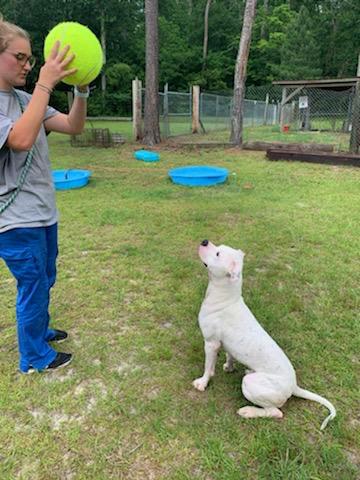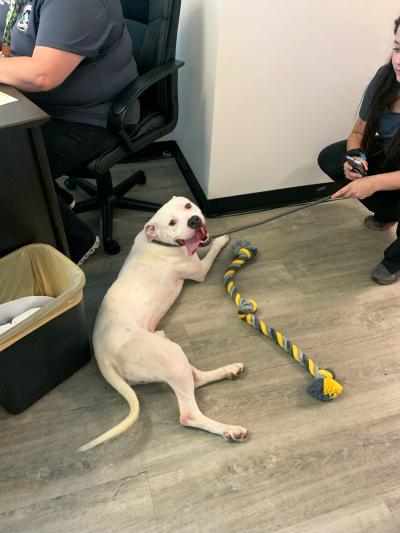Reviving the spirit of a South Carolina animal shelter

Captain Justin Wyatt of the Horry County Police Department remembers the day in the fall of 2020 when his boss tasked him with taking charge of the animal shelter in Conway, South Carolina. “I went home and told my wife that I must have made someone really mad,” he says.
The Horry County Animal Care Center, which serves a county larger than Rhode Island, was underfunded, overcrowded and had a less-than-stellar save rate. Located near Myrtle Beach, it also serves the communities of Loris, Aynor, Nichols, Galivants Ferry and other small towns.
“In general terms, it was a hot mess,” says Capt. Wyatt, his congenial, down-home South Carolina drawl unintentionally masking the seriousness of the situation. “We had a high euthanasia rate that wasn’t good for the community’s reputation. People here just thought euthanizing animals is just what shelters do. We didn’t know there were other answers besides putting animals down.”
Carrie Ducote of Best Friends says the shelter’s low save rate caught her attention, and it was something we hoped to help with. “After Capt. Wyatt took over the leadership of the shelter,” she says, “I contacted him to see if he would be open to partnering with us (to assist them in increasing their save rate). He immediately said yes, and we went from there.”

Animal shelter assessment leads to mentorship
Best Friends mentorships are designed to help animal shelters be better at everything they do. It’s one way we’re working toward no-kill nationwide by 2025.
In March of 2021, Carrie, along with fellow Best Friends staff members John Graves and Nick Walton, were invited to travel to Conway to take a look at the shelter. “We saw a staff that was very loyal and dedicated, and we were immediately struck by how long staff members had been there,” Carrie says. “They were also very loyal to Capt. Wyatt and his vision for improving the shelter and they embraced us with open arms.”
Having an outside group come in to assess a facility you are in charge of, says Capt. Wyatt, was a bit unnerving. But the day he walked in and saw Carrie, John and Nick cleaning kennels and heard their recommendations, he was at ease. “That’s when I began to learn there are other options out there (besides euthanasia),” he says. “I took a leap of faith. I suggested to our staff that we just go all in (on changes), and if it doesn’t work, we can go back to what we were doing.”
The mentorship included teaching the staff how to make changes that would ultimately raise the shelter’s save rate: implementing new ways of managing intake, increasing adoption activity and showing the shelter’s behavior team how to work in ways that would ensure more animals make it out of the shelter alive.
A grant of $36,000 from Best Friends jump-started a community cat program, which was a key driver in the shelter being able to manage a large and steady influx of community cats more effectively. The grant paid for surgeries and supplies for lifesaving programs (feral dens, handling supplies, humane deterrents, enrichment supplies), as well as virtual and in-person training on kitten intake diversion, kitten medical care, complaint mitigation, cat behavior and handling. It also included the creation of printed marketing materials for cat programs and ongoing coaching calls.
[Transformative changes for cats at York County SPCA]
This year, Best Friends awarded an additional grant of $10,000 for community cat program sustainability. It was presented in the form of a “challenge grant,” meaning that Horry County had to raise $5,000 in order to receive the entire sum. Included were fundraising coaching and resources so that the shelter would be equipped to raise its own program funds.
From all reports, the program has been a rousing success, and Capt. Wyatt and his staff are forging ahead. By the end of 2021, they increased their dog and cat save rate from 64% to nearly 84%.That represents nearly 1,000 more dogs and cats saved in 2021 compared with 2020. It was the ninth best save rate improvement among more than 4,000 animal welfare agencies reporting data.
Besides a big improvement in save rate, the center staff also received valuable training to address the organization’s biggest challenge: helping dogs who show difficult behavior in the shelter. “We were giving these dogs a home, but we didn’t know how to fix their little quirks,” says Naomi Jenkins, kennel supervisor. “We didn’t know where to start. We were used to cleaning up after the dogs, but when we saw aggression, we didn’t know what to do.”

Ghost shows the way
A white boxer-type dog named Ghost typified the shelter’s more challenging residents. He wouldn’t allow the medical staff to get anywhere near him. An obvious neck injury indicated that he quite possibly was in pain. Perhaps that was the reason why he snarled and lunged at caregivers when they approached his enclosure. One thing was clear: He didn’t want to be messed with — or so everyone thought.
Tierney Sain, Best Friends mentorship specialist, spent several days working directly with the Horry County staff. As she walked by Ghost’s kennel one day, she noticed that he knew the cue “sit.” Perhaps, she thought, that might be a key to helping him overcome his initially defensive behavior.
“He seemed very treat motivated,” she says, “and after a couple of times offering him high-value treats, he gave me much more loose body language as if to say, ‘You’re cool. Now, can you get me out of this kennel?’ We got him out the first day and it got easier and easier each time.” It was one example the team could show the Horry County staff about how to use a dog’s body language to help evaluate and manage behavior.
Naomi says it’s a perfect example of how one troubled dog can make a complete turnaround. A woman who lives in nearby Myrtle Beach came by the shelter looking for a dog to provide her with companionship. “They hit it off right away,” she says. A few weeks later, she called back to thank the team at the shelter for letting her adopt Ghost, her new friend.

Avoiding misunderstanding
Tierney also helped the staff identify other common issues affecting dog behavior, such as avoiding assumptions, predictions and labels routinely and inaccurately placed on dogs. "Describing a dog as aggressive doesn't provide detailed information about the dog’s behavior and is often an assumption we've created based on something we might think to be true, such as telling potential adopters that a dog doesn't like kids,” Tierney says. “There's usually a more accurate and factually transparent way to say it."
Part of Tierney’s work was teaching staff members to avoid a common challenge at shelters: misinterpreting a dog’s behavior. “A person sees the dog misbehaving but the dog sees it as the solution to a problem they are having,” says Tierney.
[Dogs : Common Behavior Issues]
Barrier reactivity and barrier frustration are two of the ways that a shelter dog’s behavior can be interpreted, she says. A dog might react to someone approaching his barrier by barking and lunging with teeth showing. “The dog could be telling you that he is not OK with you opening that gate, or could be telling you, ‘I’m going crazy here. Please get me out.’”
“In barrier frustration, the dog is cooped up in the kennel in a stressful environment that could be causing the barking or some other excited energy; however, the bark is more of a demand bark rather than antagonistic. Plus, the rest of the body language could be interpreted as friendly, loose, wiggly natural and comfortable.”

New vision, new practices
“The mentorship has helped open our eyes,” says Naomi. “Before, all we knew was how to take a dog out and throw a ball.”
Since the mentorship, the shelter staff members have instituted many new practices and also have basic supplies and equipment that help them help the dogs: treat bags, for example. “Tierney let us know that this is a mandatory thing to keep on us at all times for enrichment throughout the day,” says Naomi. “Also, good leashes. Each person has to walk five dogs a day. Previously, we didn’t have food puzzle bowls. And we’ve bought enrichment equipment (a jungle gym for the dog play area) and we built a new meet-and-greet area up front.”
[Enrichment for Dogs in Shelters]
Future plans include two new different types of enrichment areas, one with water and the other with turf so dogs can easily be taken outdoors. “We currently take them to our back field, but it would be easier to just open the gate, let them run and then put them back through the gate.”

Bright future for pets in Horry County
“We’re making an amazing turnaround and there are lots of accolades to go all around,” says Capt. Wyatt, “but it wouldn’t have happened without Best Friends. They (Carrie, John, Nick and Tierney) reached out to us and showed us how to be open to trying new things.”
The mentorship program is all about helping shelters make changes for the better to help both pets and their people. And the way Captain Wyatt sees it, change is a necessary part for achieving success in every organization.
“One of the things I’ve learned about the animal welfare world is that people are very passionate about it,” he says. “Some have been working at it 20-30 years and it’s hard to get them to change. We weren’t open to new ways of trying things, but the Best Friends mentorship showed us how. And without evolving, in my book, you are kind of moving backwards.”

Make a difference
Help animals through a Best Friends Network partner like Horry County Animal Care Center.
Read more
Best Friends satellite foster programs take off